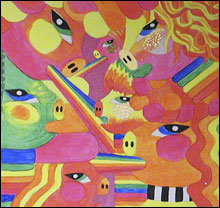In recent decades, graphic novels have gone from grabbing street cred to gaining academic credibility. Similarly, once the realm of comic books and Saturday morning kids’ shows, cartoon-inspired graphic styles hves inspired many an energetic young artist these days. A show at Gallery Agniel (through March 11) is a dynamic showcase of several such artists.
A wide cross-section of hip images is on display: digital art on monitors, appropriations of pop icons, slogan- and drawing-emblazoned buttons, and even outright comic strip panels and animation cells. Perhaps most remarkable is that a good sampling of this work is available at prices ridiculously affordable for an art gallery, from $2 buttons by Noah Lyon (“Cheap Little Tart,” “I See Dead People”) to a $20 visual mix tape by Paper Rad.
All the artists except the latter, based in Northampton, Massachusetts, are exiles from Fort Thunder, the Providence collective of underground artists and musicians that got gentrified out of existence in 2001.
Paper Rad, comprised of Jacob Ciocci, Jessica Ciocci, and Benjamin Jones, is the name  known most widely. The Agniel show presents their work with as many bells and whistles as does their tooting calliope of a Web site (www.paperrad.org). Representative of their style are sections of both color and black-and-white wallpaper, Where Are They Now?, with head shots of such familiar faces as: Mario, sweating and bruised; Miss Piggy, fretting with hands on cheeks; and an unchangeably placid Garfield. The same group is animated in a two-minute animation loop from a larger installation.
known most widely. The Agniel show presents their work with as many bells and whistles as does their tooting calliope of a Web site (www.paperrad.org). Representative of their style are sections of both color and black-and-white wallpaper, Where Are They Now?, with head shots of such familiar faces as: Mario, sweating and bruised; Miss Piggy, fretting with hands on cheeks; and an unchangeably placid Garfield. The same group is animated in a two-minute animation loop from a larger installation.
Two of the Paper Rad artists are also represented separately. There are comic strip panels by Jones and two paintings from his Comic Workshop series, which have cartoon characters frozen in various actions, from laughing to startled. Jessica Ciocci’s two The Pigs Come Out at Night paintings stray a bit from the solid-color paint-on-celluloid animation cells that much of this work refers to; actual brush strokes provide texture and human presence with these festive heads of partying pigs merging with their carnival-bright backgrounds.
Collages are to visual appropriation what mix tapes are to aural sampling. Yet the two works by Jungil Hong and Brian Chippendale don’t take the easy out of tossing cultural icons into new context or juxtapositions. (The sheets of images they start with, like paper doll cutouts, are available to peruse, if you’re interested.) Hong’s Tree Top Trading Post looks like it could be a painting, until you get close enough to see that individual images have been assembled and applied. Figures of birds and rural people from Korea, where she was born, tell a story hinted at by the account of a dream that’s on hand in place of an artist statement. Both dream and collage tell of underworld bird people who go about with bottomless bags of green leaves and “bring new life to ones asleep.”
Chippendale’s collage, Where Human Meets the Future, is equally colorful and is filled with dystopian images you might expect from fever dreams of genetic engineering: a robot with a concerned expression is looking at humans with animal heads and a garden sprouting body parts and fish as well as plants.